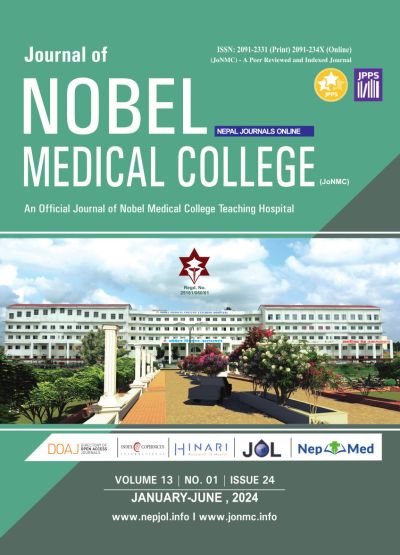Effect of Abdominal Girth and Vertebral Column Length in Spread of Spinal Anesthesia for Lower Limb Surgery: A Prospective Study
DOI:
https://doi.org/10.3126/jonmc.v13i1.68053Keywords:
Bupivacaine, Lower extremity, PatientsAbstract
Background: Subarachnoid spread of local anesthetics is quite erratic and is determined by several factors. There is a high predictive for the spread of spinal anaesthesia in terms of abdominal girth and vertebral column length. Our study is designed to determine the effect of abdominal girth and vertebral column length with cephalad spread of spinal anaesthesia for a given dose of 0.5% hyperbaric bupivacaine in Nepalese patients.
Materials and Methods: In this prospective observational study, a total 100 patients of ASA PS I-II, aged16-65 years and undergoing lower extremity surgery under spinal anesthesia were enrolled. 2.8 mL of 0.5% hyperbaric bupivacaine was injected intrathecally at L3-4 interspace in sitting position. Extent of sensory blockade was assessed for 60 min. Simple linear regression, multiple linear regression and Pearson’s correlation coefficient analysis were performed to determine the correlation between patient variables viz abdominal girth, vertebral column length, height, weight, body mass index and age and maximum sensory block height.
Results: Abdominal girth and vertebral column length correlated significantly with the maximal sensory block height after intrathecal administration of a fixed dose of 0.5% hyperbaric bupivacaine by all the three statistical tools used.
Conclusion: Abdominal girth and vertebral column lengthcorrelate significantly with the maximal sensory block height in Nepalese patients receiving a fixed dose subarachnoid block with 0.5% hyperbaric bupivacaine
Downloads
Downloads
Published
How to Cite
Issue
Section
License

This work is licensed under a Creative Commons Attribution 4.0 International License.
JoNMC applies the Creative Commons Attribution (CC BY) license to works we publish. Under this license, authors retain ownership of the copyright for their content, but they allow anyone to download, reuse, reprint, modify, distribute and/or copy the content as long as the original authors and source are cited.




